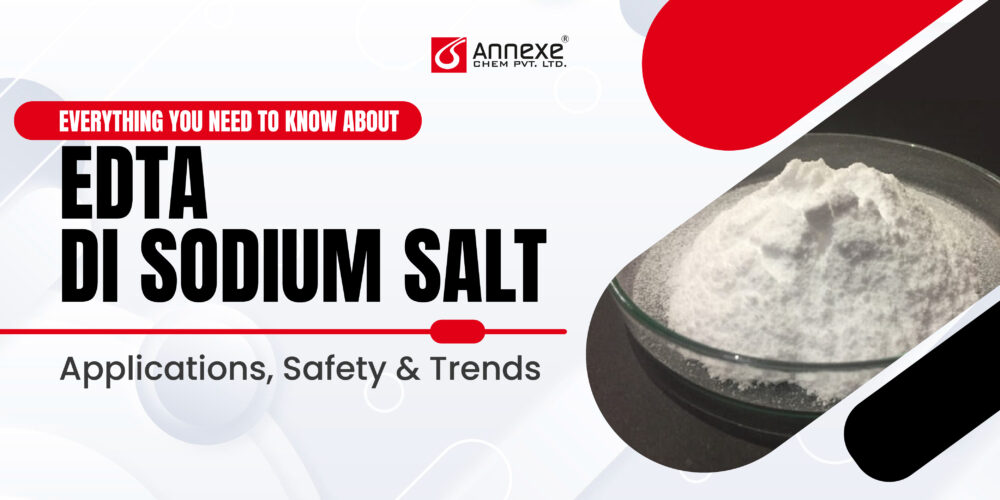Everything You Need to Know About EDTA Di Sodium Salt: Applications, Safety & Trends - Annexe Chem Pvt Ltd
Everything You Need to Know About EDTA Di Sodium Salt: Applications, Safety & Trends

- September 17, 2024
- By Akshita Patel
EDTA Di Sodium Salt may not be a household name, but its impact is felt across a wide range of industries—from healthcare to water treatment and cosmetics. As a powerful chelating agent, this versatile compound binds to metal ions, playing a crucial role in everything from purifying drinking water to stabilizing beauty products. In this blog, we’ll dive into the science behind EDTA Di Sodium Salt, explore its diverse applications, and uncover why it remains a go-to solution in industries striving for both efficiency and safety. Whether you’re in manufacturing, pharmaceuticals, or just curious about the ingredients in your skincare products, understanding EDTA Di Sodium Salt can reveal its surprising importance in everyday life.
What is EDTA Di Sodium Salt?
EDTA Di Sodium Salt, or ethylenediaminetetraacetic acid disodium salt, is a water-soluble compound with the chemical formula C₁₀H₁₄N₂Na₂O₈. It belongs to the broader class of chelating agents, substances that can form multiple bonds with a single metal ion, effectively binding and neutralizing it. Structurally, EDTA consists of two amine groups and four carboxyl groups, which provide multiple sites for binding to metal ions. This ability to form strong complexes makes it ideal for capturing metals such as calcium, magnesium, and iron.
EDTA Di Sodium Salt is commonly found in crystalline or powdered forms and is highly soluble in water, which enhances its versatility across different industries. It can also exist in various pH-adjusted formulations, making it suitable for different chemical environments and applications.
As a chelating agent, EDTA Di Sodium Salt works by binding to metal ions and forming stable, water-soluble complexes. This process prevents metals from reacting with other compounds, thereby inhibiting unwanted reactions such as oxidation or corrosion. This chelating action is particularly useful in processes like water purification, where it binds to heavy metals, and in cosmetics, where it stabilizes formulations by preventing degradation caused by metal ions.

Applications of EDTA Di Sodium Salt
Industrial Applications Of EDTA Di Sodium Salt
- Use in Water Treatment and Purification: One of the most significant applications of EDTA Di Sodium Salt is in water treatment. In municipal and industrial water systems, metal ions like calcium, magnesium, and iron can cause scaling, clogging, and reduce system efficiency. EDTA Di Sodium Salt acts as a chelating agent, binding to these metal ions and removing them from the water. This process not only prevents scaling but also improves the overall quality of water, making it safer for industrial use and human consumption.
- Role in Metal Cleaning and Plating: EDTA Di Sodium Salt is widely used in metal cleaning and plating industries due to its ability to dissolve and remove metal ions from surfaces. In metal cleaning, it helps in removing rust, scale, and other metal deposits, preparing surfaces for further treatments. In metal plating, EDTA ensures that the metal ions in plating solutions remain soluble and uniformly distributed, leading to smoother, more consistent plating results. By maintaining the right balance of metal ions, EDTA also prevents impurities from affecting the quality of the final product.
Pharmaceutical and Medical Applications Of EDTA Di Sodium Salt
- Utilization in Chelation Therapy: Chelation therapy is a medical treatment used to remove heavy metals, such as lead, mercury, and iron, from the body. EDTA Di Sodium Salt is an effective chelating agent used in this therapy because it binds to toxic metals in the bloodstream, allowing them to be safely excreted through urine. This treatment is especially beneficial for patients suffering from heavy metal poisoning or conditions like hypercalcemia (excess calcium in the blood). By clearing the body of harmful metals, EDTA Di Sodium Salt plays a critical role in improving patient health.
- Use as a Preservative in Pharmaceuticals: In pharmaceutical formulations, EDTA Di Sodium Salt acts as a stabilizer and preservative. It binds with trace metal ions that could otherwise promote the degradation of active ingredients in medications, particularly in solutions and ointments. By preventing oxidation and other metal-catalyzed reactions, EDTA helps extend the shelf life and maintain the efficacy of pharmaceutical products. Its preservative function is especially valuable in injectable and ophthalmic solutions, where maintaining sterility and stability is crucial.
Use Of EDTA Di Sodium Salt in Cosmetic and Personal Care Products
- Function as a Stabilizer in Creams and Lotions: In cosmetics and personal care products, EDTA Di Sodium Salt serves as a stabilizing agent. Many cosmetic formulations contain trace amounts of metal ions, which can cause unwanted chemical reactions, leading to product discoloration, spoilage, or reduced effectiveness. EDTA Di Sodium Salt binds to these metal ions, preventing such reactions and thereby stabilizing the product’s formulation. In creams and lotions, it helps maintain texture, color, and potency, ensuring a longer shelf life and a more reliable performance for the user.
- Use in Hair Care and Skincare Products: EDTA Di Sodium Salt is commonly found in hair care and skincare products for its ability to improve product performance. In shampoos, conditioners, and facial cleansers, EDTA helps soften hard water by binding with calcium and magnesium ions, allowing the products to lather better and cleanse more effectively. In skincare formulations, it enhances the effectiveness of active ingredients by ensuring that metal ions do not interfere with their action. This makes EDTA a key ingredient in maintaining the quality and performance of personal care products.
Application Of EDTA Di Sodium Salt In Food Industry
- Application as a Preservative and Antioxidant: EDTA Di Sodium Salt plays a crucial role in the food industry as a preservative and antioxidant. It helps prevent oxidation, a chemical reaction that causes food spoilage, by binding to metal ions that act as catalysts for oxidation. By doing so, EDTA prolongs the freshness of various food products, such as canned goods, beverages, and processed foods. In particular, EDTA is effective in preserving the color, flavor, and nutritional content of foods by preventing oxidation-related deterioration.
- Use in Enhancing Food Stability and Appearance: In addition to its preservative function, EDTA Di Sodium Salt is used to improve the stability and appearance of food products. It helps prevent undesirable changes in color, texture, and flavor that can occur due to metal-catalyzed reactions. For example, in salad dressings and mayonnaise, EDTA prevents the oils from becoming rancid, thereby maintaining product freshness. In canned vegetables, it helps retain vibrant colors and improves the visual appeal of the food. By enhancing both the stability and appearance of food, EDTA contributes to higher-quality products that are more appealing to consumers.
Through its wide-ranging applications, EDTA Di Sodium Salt proves to be a valuable compound in multiple sectors, from industrial processes to healthcare, personal care, and food production. Its ability to bind metal ions and prevent unwanted reactions makes it indispensable in improving product quality, stability, and safety.
Safety Considerations While Using EDTA Di Sodium Salt
While EDTA Di Sodium Salt is widely used across industries, safety is a key concern when handling and applying this compound. Regulatory bodies like the FDA and international organizations have established guidelines to ensure its safe use, particularly in food, pharmaceuticals, and personal care products. EDTA Di Sodium Salt is generally recognized as safe in limited quantities, but overexposure can lead to potential health risks, such as skin irritation or gastrointestinal issues. In medical applications, especially in chelation therapy, careful dosage control is crucial to avoid complications. Additionally, its environmental impact must be managed, as improper disposal can harm aquatic ecosystems by binding essential metal ions. Responsible use, proper handling, and adherence to regulatory standards are essential to ensure both human and environmental safety.
Future Trends and Developments For EDTA Di Sodium Salt
As industries continue to evolve, EDTA Di Sodium Salt is finding new applications and undergoing innovations to meet modern demands. In the industrial sector, research is focused on developing more eco-friendly and biodegradable alternatives to reduce the environmental impact of EDTA, particularly in water treatment and metal processing. Additionally, advancements in pharmaceutical and medical fields are exploring the use of EDTA derivatives for more targeted and efficient chelation therapies.
In cosmetics and personal care, EDTA’s role as a stabilizer is expected to expand as formulations become more complex, especially with the rise of natural and organic products. The food industry is also seeing increasing interest in EDTA as a preservative, with ongoing studies aiming to enhance its effectiveness while ensuring sustainability.
Moreover, regulatory bodies are pushing for stricter controls on EDTA usage to minimize its ecological footprint, spurring innovation in recycling and recovery technologies. As industries seek greener solutions, EDTA’s future lies in its ability to adapt to sustainability trends while maintaining its essential role in product stability and safety.
EDTA Di Sodium Salt plays an indispensable role across a wide array of industries, from purifying water and preserving food to enhancing the stability of cosmetics and pharmaceuticals. Its ability to bind with metal ions makes it a versatile and powerful compound, solving challenges in product safety, quality, and efficiency. However, with growing concerns about its environmental impact, industries are seeking greener alternatives and innovations to ensure sustainable use. By understanding its applications, benefits, and safety considerations, we can continue to harness the power of EDTA Di Sodium Salt while striving for a more eco-friendly future.

Akshita Patel
As an advocate for sustainability, Akshita is committed to driving positive change within the chemical industry. She actively seeks out environmentally friendly solutions and promotes the adoption of sustainable practices. Akshita believes that a balance between economic growth and ecological responsibility is crucial for the industry's long-term success. She is dedicated to finding innovative ways to minimize environmental impact while maximizing efficiency and profitability.
Related Blogs

- February 7, 2024
- By Akshita Patel
Magnesium Gluconate: Your Daily Source Of.
The chemical structure of magnesium gluconate is C12H22MgO14. Magnesium gluconate is a form of magnesium supplement.

- May 12, 2025
- By Akshita Patel
Why Citric Acid Anhydrous is a.
Ever wondered what gives your favorite fizzy drink its tangy kick or keeps your skincare products.



